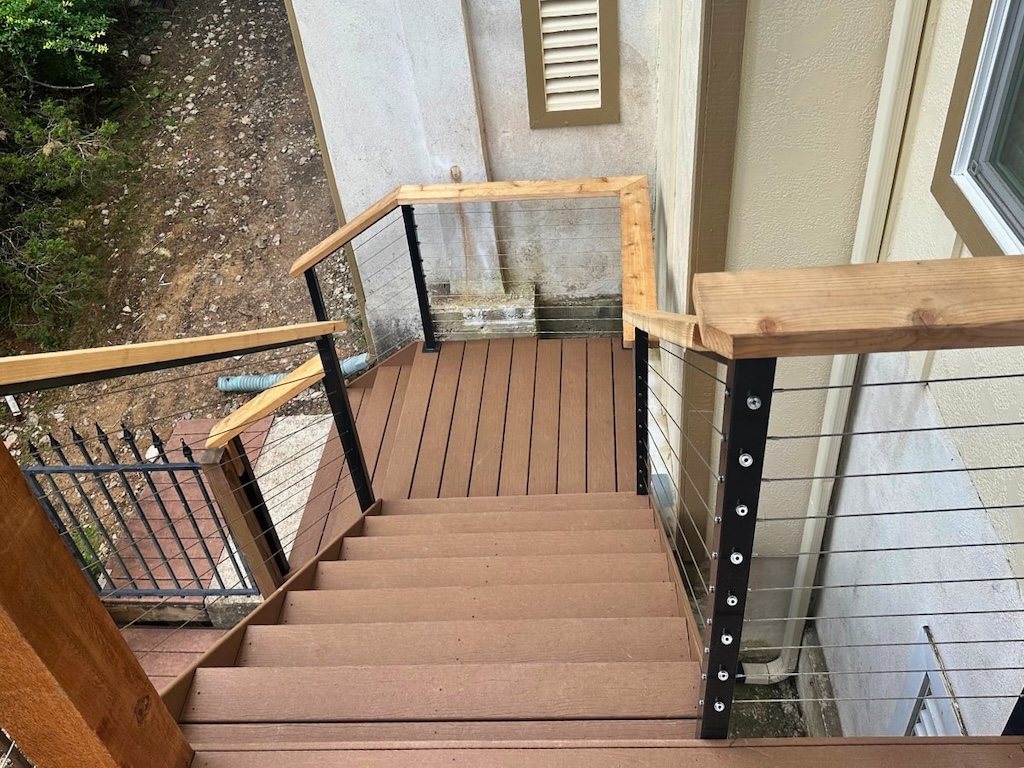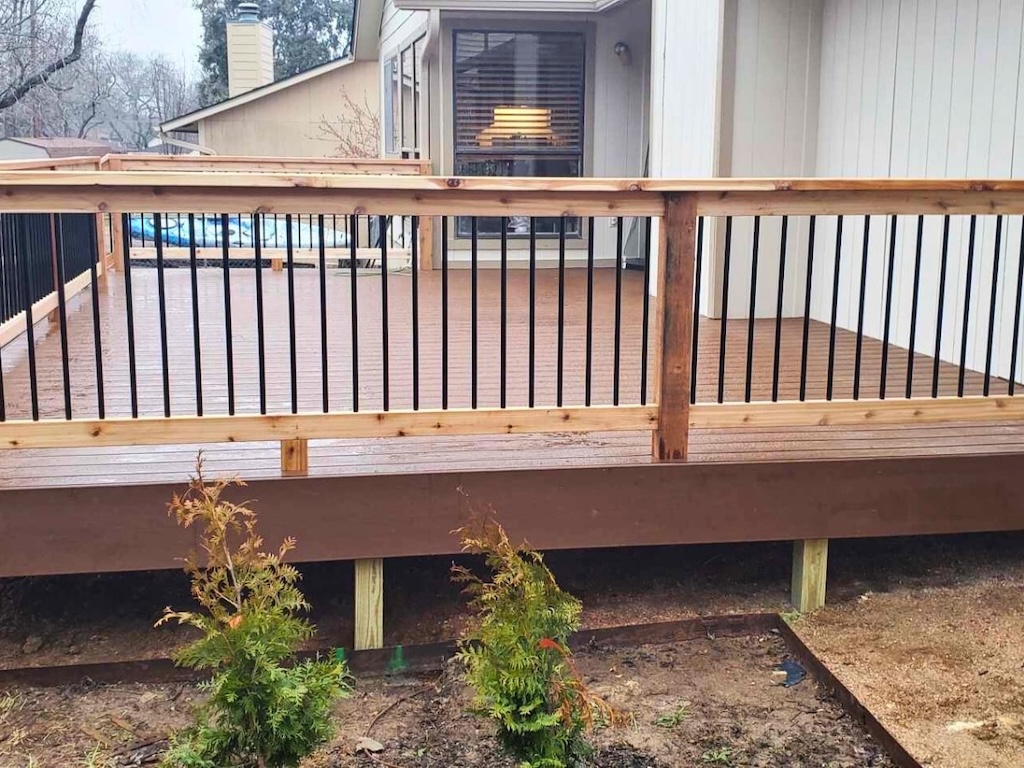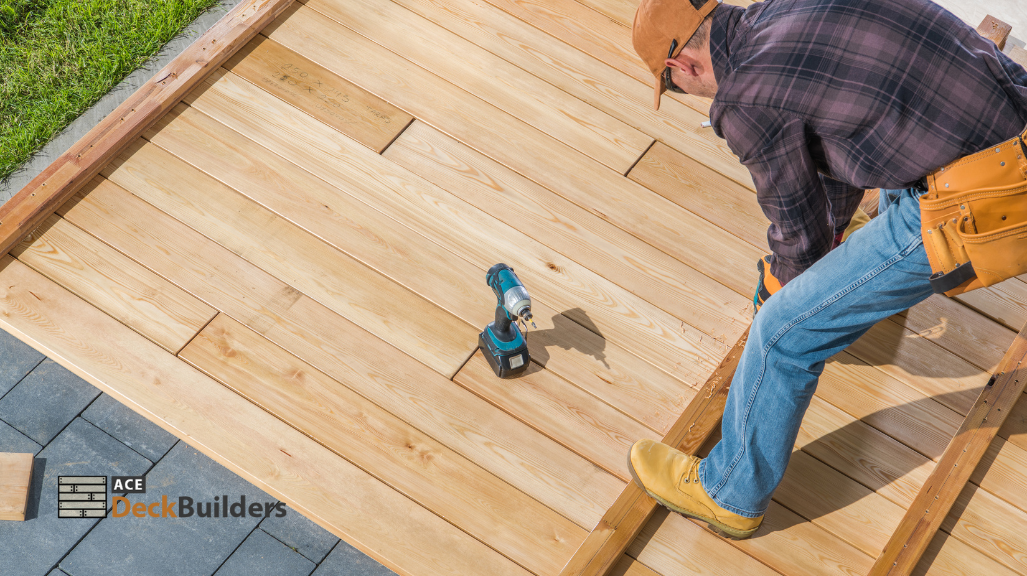TL;DR
Most Austin homeowners spend $9,500–$28,000 to replace a typical residential deck, with material choice (cedar vs. composite/PVC), size/elevation, railing complexity, and site access driving the range. Expect permits, inspections, debris removal, and hardware upgrades to be included in a comprehensive quote. You’ll get the best value by standardizing your bids (same size, materials, railing count), choosing in-stock options, and planning for inspection “hold points.” For an example of the process and finish quality to expect locally, browse the portfolio and process on Ace Deck Builders.
Table of Contents
ToggleWhy Replacement Costs Vary in Austin

Two 300-square-foot decks can be priced very differently. Here’s what changes the math in Central Texas, affecting overall deck costs :
- Elevation & access: Multi-level layouts, steep yards, and tight side yards add labor hours for staging, hauling, and safety.
- Railing & stairs: Rails are a significant cost driver; code-compliant posts, infill, and stair geometry take time and hardware.
- Materials: Cedar is lower upfront but needs finishing cycles; composites/PVC cost more initially but reduce maintenance.
- Hardware & structure: Post bases, ledgers, flashing, joist spacing, and span requirements differ by material and elevation.
- Demolition & haul-off: Old framing often hides rot, rusted hardware, or undersized footings; professional crews plan safe demo and disposal.
- Permits & inspections: Even simple replacements can trigger permit review and inspections for footing/framing/final work.
- Finish details, including skirting, fascia, lighting, and privacy screens, elevate both the look and budget.
Quick Pricing Snapshot (By Size & Material)
Below are typical Austin ranges for complete tear-off and replacement (decking, rails, stairs, standard framing refresh). Actual quotes depend on your specs, site, and inspections.
- Small (200–250 sq. ft.)
- Cedar: $9,500–$14,000
- Mid-range composite: $13,500–$18,500
- Premium composite/PVC: $16,500–$22,000
- Medium (300–400 sq. ft.)
- Cedar: $12,500–$19,500
- Mid-range composite: $17,500–$25,500
- Premium composite/PVC: $21,500–$30,000+
- Large (450–650 sq. ft., multi-stair/rail)
- Cedar: $18,500–$28,000
- Mid-range composite: $25,000–$38,000
- Premium composite/PVC: $32,000–$48,000+
Notes:
- Add for complex rail infill (cable, glass), extra landings, shade structures, or engineered spans.
- Subtract if stairs/rails are limited or you’re reusing a compliant substructure (rare—most frames need upgrades to current standards).
What’s Usually Included in a Professional Replacement
A thorough, transparent proposal should itemize:
- Demolition & haul-off: Safe removal, separation of materials, site protection, debris disposal.
- Structural work: New ledger/flashings, footings as required, beams/joists to current specs, and blocking at rail posts/stairs.
- Decking & fascia: Specified board brand/series, fastener system (plugs/hidden), fascia ventilation where required.
- Rails & stairs: Code heights, graspable handrails, correct post attachments, uniform rise/run.
- Finishes: Skirting, trim details, lighting rough/trim (if included).
- Permits & inspections: Plan set, submittals, inspection scheduling (footing/framing/final).
- Cleanup & closeout: Jobsite cleaning, walkthrough, punch list, care packet, warranty documents.
Line-Item Cost Drivers You Can Control
Railing length & type
- The more linear feet of rail (and the fancier the infill), the bigger the budget. Wood pickets cost less than tensioned cable or glass.
Stairs
- Every run adds framing time, code checks, and finishing labor. If the site allows, one consolidated stair run is cheaper than multiple small runs.
Decking series
- “Value” composite lines can look great but have fewer colorways and profiles; premium lines add heat-mitigation tech, embossed textures, and longer warranties.
Layout & dimensions
- Standardizing to material lengths (e.g., 12/16/20-ft boards) reduces waste. Small design tweaks can shave hundreds off material waste alone.
Skirting & fascia
- Full wrap skirting and layered fascia look finished, but this requires additional material and labor. Consider partial treatments where they matter most (public-facing sides).
Lighting & power
- Pre-wiring and fixtures have a high impact, but they also add parts, require trade coordination, and necessitate inspections (electrical work requires a licensed subcontractor).
Cedar vs. Composite vs. PVC: 10-Year Cost Reality
Upfront price is only half the story in Central Texas.

- Cedar (and other softwoods):
- Pros: Cooler underfoot; natural look; lower initial cost.
- Cons: Requires regular cleaning and stain/seal cycles every 12–24 months, depending on exposure, and may experience color shift without maintenance.
- 10-year reality: Lower upfront, higher care time/cost.
- Composite:
- Pros: Lower routine maintenance, strong color stability, and wide design choices.
- Cons: Some boards get hot; ventilation/gap rules must be followed; mid-to-high upfront cost.
- 10-year reality: Higher initial spend, lower recurring costs, consistent appearance.
- PVC (capstock/foamed):
- Pros: Offers great moisture resistance and top-tier color stability, with some lines managing heat better.
- Cons: Highest upfront cost; requires correct fastening and edge support.
- 10-year reality: Highest initial spend, minimal ongoing maintenance, premium look.
A good contractor will leave sample boards with you for a week so you can heat-test at noon vs. sundown, and will show a simple 10-year total cost comparison in the proposal.
If you want a side-by-side on installation techniques, fasteners, and inspection pacing on replacement jobs, it helps to skim a specialist’s overview of deck replacement in Austin and then compare that against material-specific notes in a focused composite deck installation guide.
For broader budget context—especially if you’re undecided between new build vs. replacement—review an Austin-specific breakdown of how much it costs to build a deck so you can benchmark your numbers.
Permits, Inspections & Engineering (When Needed)
In Austin, replacement doesn’t always mean “like for like.” Elevation, footprint changes, and structural upgrades can trigger permit review. Expect at least, depending on the deck size :
- Footing inspection (if new piers are poured): the inspector needs to see depth/diameter and soil before concrete.
- Framing inspection: ledger flashing, fastener patterns, joist spans, rail post connections—all visible before decking covers anything.
- Final inspection: guard height, stair geometry, lighting trim, and overall safety.
Engineering may be prudent or required for rooftop/elevated decks, spas, or longer spans. Ask your contractor to explain when and why stamped details are recommended.
Project Timeline & How It Affects Budget
Time is money—literally. Replacements that cause delays lead to additional mobilization and rescheduling costs. A realistic schedule after approvals:
- Demo & haul-off: 1–2 days (more if access is tight).
- Footings (if needed): 1–3 days + inspection + pour.
- Framing: 3–6 days + framing inspection.
- Decking/rails/stairs: 4–8 days, depending on complexity.
- Finishes & punch: 1–3 days + final inspection.
Plan buffers for weather and inspection queues. A builder who controls inspection hold points keeps the calendar—and budget—on track.
How to Compare Quotes Apples-to-Apples
Ask each contractor to quote the same spec:

- Size & layout (length × width, elevation, stairs count).
- Decking series & color (brand/line).
- Railing system (style, linear feet, stair rail).
- Skirting & fascia (where and how many linear feet).
- Hardware details (post bases, flashing, fasteners).
- Permits & inspections (who pulls; who meets inspectors).
- Allowances (rock excavation, hidden rot repair, extra piers).
- Exclusions (irrigation repair, landscaping, furniture).
- Schedule & hold points (footing, framing, final).
- Warranty terms (workmanship + handling of manufacturer claims).
When proposals differ by thousands, it’s almost always a scope difference—rail length, stair count, or decking series.
Ways to Save Without Regret
- Standardize dimensions to material lengths (12/16/20-ft).
- Simplify railings (wood or composite pickets vs. cable/glass).
- Consolidate stairs to one well-placed run.
- Defer non-structural extras (screens, benches) to phase two.
- Choose in-stock boards & rail kits to avoid delays and price jumps.
- Protect framing with correct ventilation and details; it saves money long-term.
FAQs
Only if the structure meets current standards and is in solid condition, many decks need ledger, footing, or joist upgrades. Your contractor should show inspection notes or a detail sheet to justify reuse.
Railing length and type, including options for composite decking. Cable/glass systems look great, but add hardware and labor. Stair rails are pricier than level runs.
Lifespan depends on framing quality and care, but composites/PVC typically deliver better long-term appearance and lower maintenance than softwoods—especially under high UV.
A typical medium deck is 2–4 weeks on site after approvals and materials, assuming clean inspection passes and reasonable weather.
Not recommended. Contractors familiar with Austin’s process will submit cleaner drawings, meet inspectors, and handle revisions faster—usually worth more than any permit admin savings.
Get Your Austin Deck Priced Right
Want an itemized, apples-to-apples replacement quote with options for cedar, composite, and PVC—plus a realistic schedule tied to inspection hold points? Start with a free deck estimate in Austin. We’ll map the scope, show heat/UV trade-offs with samples, and give you a clear plan from tear-off to final walkthrough—no guesswork in your decking project.
